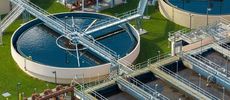Updates on the US EPA Microbial/Disinfection By-Product (MDBP) Rule


Every six years the US Environmental Protection Agency (EPA) is required by statute to periodically review all the rules under the Safe Drinking Water Act (SDWA). The two main considerations EPA has during this review process are to determine if there are opportunities to improve public health and opportunities to reduce implementation and compliance costs to drinking water systems. These two objectives are not mutually exclusive.
The fourth six-year review was initiated in October of 2018, which put in motion a series of steps, described in detail here.
Initial Review: To identify regulations for which a detailed technical review would or would not be needed. EPA reviewed newly available data, information, and technologies, and then identified eight NPDWRs as candidates for revision and are: Chlorite, Cryptosporidium, Haloacetic acids, Heterotrophic bacteria, Giardia lamblia, Legionella, Total Trihalomethanes, and viruses. These eight are included in the following microbial and disinfection byproducts (MDBP) rules:
- Stage 1 and Stage 2 Disinfectants and Disinfection Byproduct Rules (DBPR)
- Surface Water Treatment Rule (SWTR)
- Interim Enhanced Surface Water Treatment Rule (IESWTR)
- Long Term 1 Enhanced Surface Water Treatment Rule (LT1)
Health Effects: Drinking water contaminants are reviewed to identify those that might need revision of their maximum contaminant level goal (MCLG) and maximum contaminant level (MCL). This process includes a review of the Contaminant Candidate Lists (CCL).
Contaminant Occurrence and Exposure Analysis: Information on the frequency, levels, and geographic distribution of contaminants is analyzed to determine how changing an MCL, adding a new contaminant/MCL, or changing treatment technique may affect health risks and/or impact compliance costs for public water systems. This was done through an Information Collection Request (ICR) process, which was reviewed by the Office of Management and Budget (OMB) in 2019 and sent to Primacy Agencies (states) in June 2020. This data on contaminants will help EPA determine if current rules are sufficient or need updating. Historical compliance monitoring data and treatment technique information were collected, covering a period from January 2012 to December 2019, and were released by EPA in 2022.
Analytical Method Improvements: Methods are evaluated to determine whether there have been advances in laboratory technology to potentially enable a revision to the MCL for a regulated contaminant. However, the EPA is only allowed to consider methods developed within the agency, to determine if there have been method improvements, such as lower detection levels can be achieved, that could afford a lowering of a particular MCL. The process to evaluate other methods outside of EPA, such as those developed by third parties using the Alternative Test Protocol (ATP) process or methods from consensus standards bodies, is another process within the agency.
Treatment Methods Feasibility: Review of treatment methods to determine if there are new or improved technologies that could support a potentially lower MCL or a new treatment technique requirement. Several EPA drinking water rules do not have an MCL but are assumed to be effectively managed through treatment techniques. Some examples are Heterotrophic Plate Count (HPC), Legionella, Giardia, Cryptosporidium, copper, and turbidity rules. In this phase of review, the EPA reviews if any improved or less expensive technologies are available that are at least as protective of public health as compared to the existing prescribed treatment techniques, might be adopted and, therefore, change a rule's status from a Maximum Contaminant Level Goal (MCLG), which is not enforceable, to and enforceable MCL.
Risk-Balancing: This process is conducted to address whether a change to an MCL and/or treatment technique will affect the risk from other contaminants, and, if so, to consider revisions that will balance multiple risks. Risk-balancing only applies to the MDBP rules, since it is a delicate balance to ensure effective disinfection with microbial risk, and the agency is required to manage both types of risk. This is one area when input from other agencies and subject matter experts can be of great value to the EPA.
Implementation Issues: Are considered based upon EPA's or states' experience in implementing the regulations as written, for example, are the contaminants and associated methods sufficiently understandable for utilities to adopt? If the rule(s) were to change, what would be the public health benefit versus the cost to utilities? Does the health benefit outweigh the cost and, therefore, justified? These types of questions are also ones that EPA puts to primacy agencies, utilities, other agencies, health professionals, and other subject matter experts.
As you can tell from the above text, not only is EPA required to perform the six-year reviews, but they are also obligated to engage with primacy agencies, the regulated community, other industry stakeholders, and the public. This engagement can happen in a few different ways, some regulated and/or required, and others by choice.
One fairly prompt decision the EPA made was to engage in the Federal Advisory Committee Act (FACA) process, which also allowed EPA to extend the original rule proposal deadline from July 31, 2024, to July 31, 2025, while the final rule, initially scheduled for September 30, 2027, was moved to October 2, 2028. These completion dates were allowed to be moved due to a clause in the Consent Decree decision EPA has with the Water Keeper's Alliance (March 25, 2020). More details on the Consent Decree can be found here: www.regulations.gov/document/EPA-HQ-OGC-2020-0140-0002.
EPA chose an existing Federal Advisory Committee (FAC), the National Drinking Water Advisory Council (NDWAC), and developed a charge to this group including specific objectives and timelines. After considerable deliberations, the NDWAC subcommittee
on MDBP rule revision recommendations, thirteen such recommendations were sent to the EPA in December 2023. These NDWAC recommendations are being considered by the Agency as they develop the rule proposal. In summary, the 13 NDWAC MDBP Rule Revision Recommendations address the following:
- Disinfectant Residual – Address the potential for no or low disinfectant residual in surface water Public Water System (PWS) distribution systems (DS), this includes the option for a numerical disinfection level versus 'detect.'
- Premise Plumbing – EPA should advance a national building water quality improvement initiative based on an enhanced partnership among federal agencies and state SDWA oversight agencies. This recommendation was targeted to address Legionella pneumophila and its' associated disease state, legionellosis.
- DBPs of Emerging Concern – Address data and analysis gaps associated with DBPs of emerging concern.
- Multi-Benefit Precursor Control – Establish a PWS source water evaluation screening requirement and, under defined conditions, provide additional mandatory treatment to reduce DBP formation and disinfectant demand.
- Finished Water Storage Tanks – Address finished water storage tank vulnerabilities by establishing a national inspection and cleaning as needed requirement; supported by a review and update as needed of current storage tank operations and maintenance guidance.
- Chloramination – Improve chloramination practices to promote control of microbial contamination and DBP formation potential and improve overall consistency of water quality.
- Consecutive Systems – Improve water quality and regulatory compliance rates for consecutive systems.
- Source Control – Leverage non-SDWA authorities to:
- Prevent contaminants from entering the water cycle.
- Restrict discharge into source waters.Environmental Justice (EJ) Improvement Opportunities – Conduct analyses to characterize the current gap in MDBP rule implementation and affordability pressures faced by public water systems serving EJ, disadvantaged and historically underserved communities. Provide strategies for ensuring this gap is filled and to work toward more equitable implementation of the MDBP rules across demographic groups. Ensure that new requirements can be implemented consistently, with sufficient additional resources provided to equitably receive the benefits anticipated to result from the rule revisions.
- Public Water System (PWS) Technical, Managerial, and Financial (TMF) Capacity – Provide and align additional TMF capacity for small, rural, EJ, disadvantaged, and historically underserved communities consistent with new demands placed on PWS by MDBP rules revision.
- Primacy Agency Capacity – Address SDWA Primacy Agency capacity needs to be associated with the new demands anticipated from MDBP rule revisions.
- MDBP Overall Data and Analysis Gaps – Address gaps in data and analysis related to microbial and DBP contaminants.
- Ground Water Under the Direct Influence of Surface Water (GWUDI) – EPA should revisit the definition, determination methods, and guidance for GWUDI to ascertain what changes should be made to improve the protection of public health.
Another way the EPA is required to engage the public in this rule-making process is through soliciting public comment at www.regulations.gov. This is the single most important route individuals and utilities can leverage to ensure the EPA hears your ideas, concerns, experiences, and comments. The result of this rule-making process will affect you, your utility, and your customers. Be engaged, participate in EPA webinars on this topic before the proposed rule, and submit your comments to EPA when public comments are requested. Stay up to date on the fourth six-year review activities here: www.epa.gov/dwsixyearreview.






